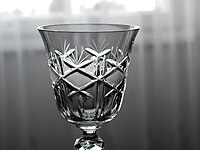
Photo from wikipedia
The fictive temperature of glass characterizes the glass network structure and its thermal history, and thereby can influence ion and water transport in the glass surface. In this study, IR… Click to show full abstract
The fictive temperature of glass characterizes the glass network structure and its thermal history, and thereby can influence ion and water transport in the glass surface. In this study, IR specular reflectance (SR), refractive index, and density measurements were used to characterize and confirm the effects of glass sample processing, especially the fictive temperature/thermal-history variations. The subsequent acid leaching of these glasses created leached surface layers due to interdiffusion and reaction of hydrous species in the surface; the hydrogen depth profiles obtained with secondary ion mass spectrometry (SIMS) confirmed enhanced leaching with increasing fictive temperature. Attenuated total reflectance (ATR) in the mid- and near-IR indicated increases in both SiOH and H2O species with increasing fictive temperature. The relative intensities and shapes of the ATR peaks were found to vary between the samples suggesting that speciation of the hydrous reaction products (eg, strong and weakly hydrogen-bonded OH) is also influenced by the original fictive temperature of the glass, but could not be quantitatively determined.
Journal Title: Journal of the American Ceramic Society
Year Published: 2017
Link to full text (if available)
Share on Social Media: Sign Up to like & get
recommendations!